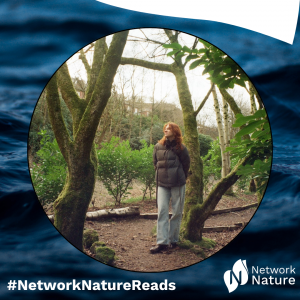
What is NetworkNature Reads?
#NetworkNatureReads is inspired by #ReadingRainbow and the #NewYorkTimes #ByTheBook series, both of which spread a love of reading by highlighting stand out books and the people who love them. Our goal is to do the same, but with a #naturebasedsolutions flavor. Every month, we will feature one book selected by a NetworkNature member. We believe that literature widens perspectives and can foster connection with human and environmental communities. Read Wild Geese by Mary Oliver if you aren’t sure what we mean.
This month’s interviewee is Oppla’s Loreta Tale. Want to get involved? Contact hello@networknature.eu to suggest a book!
Tell us about yourself! What role do nature and reading play in your life?
Growing up in Latvia, I've always lived with one foot in nature and the other in the city. Nature is my muse - it guides my creativity and soothes when things get a little too much. This balance between urban life and the natural world has constantly inspired me to think about how we can live more respectfully and connected with our environment.
As a climate science communication officer, I draw on this connection to shape how I communicate complex topics. Reading plays a key role in this, often inspiring my communication style by exposing me to diverse perspectives and writing approaches, especially in areas like ecology and mental health awareness. I’ve always been drawn to the beauty of language and the power of words, which is why I make time to read often, and to write as well.
Which book did you pick and why?
“Zen and the Art of Saving the Planet” by Thich Nhat Hanh beautifully explores the deep interconnectedness between humans and nature, emphasising how this relationship is essential to the well-being of humanity and the creation of a more regenerative world. I strongly believe that the relationship with our own selves is a reflection of how we treat others and the planet around us.
Can you share a specific moment from the book that resonates with you personally? How does it connect to your work with Nature-based Solutions projects?
One of the book’s key lessons for me is the value of compassionate, non-judgmental listening. Truly hearing others without imposing our own beliefs or assumptions helps us better understand the diverse experiences of communities affected by climate change. I keep in mind to ensure that the stories I share reflect the voices of those who live them.
This approach to listening and representation directly links to my work. In the Precilience project, this means co-developing climate adaptation solutions with farmers and foresters, grounded in their local contexts. In the MOSAIC project, we use the participatory photovoice method to share the land-use change narratives, capturing everyday realities of people living on these lands that are often overlooked.
In what ways do you see the themes or lessons from the book aligning with the goals of conservation and the challenges we face in combating biodiversity loss today?
Nature-based solutions are most effective when co-created with diverse voices, leading to more inclusive and context-specific outcomes. Cultivating empathy for ourselves and others also supports a deeper understanding of the interconnected relationships between ecosystems, species, and human activities. When we begin to value the natural world, we can shift from a mindset of exploitation to one of preservation, helping to overcome the short-term thinking that contributes to biodiversity loss.
If you were recommending this book to a colleague or a friend within the conservation community, what key takeaway or message would you highlight?
Ask yourself how your choices, behaviors, and habits contribute to both your own well-being and the greater good, enabling you to thrive and show up fully to serve life in a broader sense.
